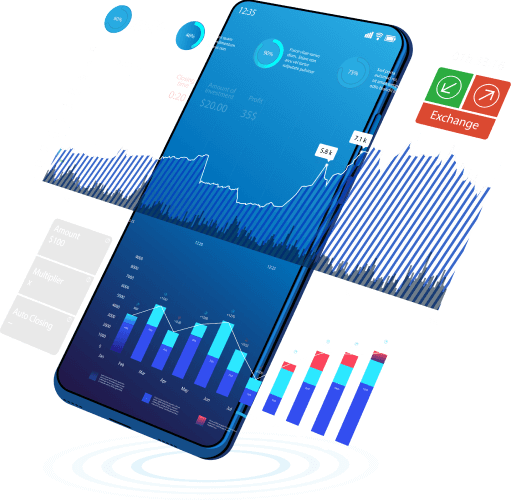Introduction to the world of Forex - An overview of the most important concepts related to Forex and the online currency trading industry.
INTRODUCTION TO FOREX
What makes forex unique?

Foreign exchange, also known as Forex, is defined as the exchanging of currencies on the global marketplace. While a currency exchange is commonly thought of in the context of physically exchanging one currency for another while traveling , Forex refers to large scale trading on a global level. With worldwide trading volume averaging $5.3 trillion every day, Forex is by far the largest and most liquid market in the world.
The characteristics of Forex trading clearly distinguishes it from traditional financial trading. In the stock market, traders purchase a stock when they think it will increase in value, and then sell it when the has peaked, or when the stock starts to depreciate. In Forex currency trading, traders will predict predict whether a currency will increase or decrease in value against another currency, referred to as a Currency Pair.For example, if a trader is working with the US dollar- Japanese Yen currency pair, (USD/JPY), he would need to determine whether the US dollar will increase or decrease in value against the Yen. If the pair is expected to increase, a buy position is placed. If it is forecast to decrease, a sell position is placed.
Currencies from all over the world are being traded against each other at any given time, the Forex market operates 24 hours a day, 6 days a week. With trading being done on such global scale, market manipulation is nearly impossible. As such, Forex trading is often called “the market closest to the ideal of perfect competition”.
Retail customers conduct their trading via a Forex broker. These brokers act as an intermediary between traders and the banks that are executing the positions. Meaning the trader does not need to be concerned with physically purchasing or trading a currency. The trader only needs to determine whether their currency pair will move up or down.
Additionally, the Forex market operates in a completely decentralized environment, with trades being conducted electronically. In other words, there is not one location where all Forex trades are recorded, unlike companies listed for trading on the New York Stock Exchange. The decentralized nature of Forex means that there is no one governing body overseeing how trading needs to be conducted.
Interpreting a currency pair

Forex trades are always conducted in pairs, with the first currency referred to as the base currency, and the second referred to as the quote currency. For example, in the USD/JPY pair, the US dollar (USD) is considered the base currency, while the Japanese yen (JPY) is the quote currency. The price of the pair is quoted in Japanese yen, meaning that if the pair is listed at a price of 106.92, 1 US dollar would be equal to 106.92 Japanese yen.
Currency pairs will always be listed with two prices. The bid price is the price traders will buy the base currency vs. the quote currency, while the ask price is the price traders will sell the base currency vs. the quote currency. The difference between the bid and ask prices is called the spread, which is measured in pips and is the cost of opening a position. In the USD/JPY example , if the bid price is 106.840 and the ask price is 106.855, the cost of opening a position for this pair would be .015 pips.
Margin trading and money management

A margin requirement is the minimum amount of money needed in a trading account in order to open a position. The value of Forex pairs are calculated in pips, which are equal to a fraction of a cent, traders are able to leverage their positions for a significantly higher amount than the actual margin required. Leverage can range from anywhere between 100:1, meaning that for every $1 in the trading account $100 can be traded, to 400:1, meaning that for every $1 in the trading account, $400 can be traded.
Leverage has both advantages and disadvantages. On100:1 leverage, clients are able to trade positions up to $100,000 with only a $1,000 deposit. That means that every pip is worth 100 times its real value. This can work either in favor or against the trader, with both profits and losses amplified by the increased value of the position. Because leverage has the ability to generate rapid fluctuations in the margin of an account, employing a proper money management strategy should be a top priority for any trader. Applying smart leveraging in advance can ensure long-term survival in the Forex market.
Rollover and the carry trade

Rollover is a concept that when effectively mastered can be applied to what is called the carry trade, which is a fantastic way to further increase your trading margin.
In the Forex market all trades are settled at the end of each trading day at 17:00 EST. Traders have the option of carrying, or rolling over, trades into the 'next day'. This is done by trade simultaneously closing and opening at the rate listed when markets start the 'new day'. Because the trade is being closed, interest on both currencies in the pair is either paid or collected by the trader, depending on whether the position was a buy or sell.
For example, on a EUR/USD the EUR is purchased against the USD . If the position is a BUY every time the position is rolled over into the next trading day, the trader collects interest on the EUR while paying interest on the USD. If the position is a SELL, the trader would pay interest on the EUR while collecting it on the USD . Interest rates are determined by the respective central bank associated with each currency. If the interest rate on the currency being purchased is higher than the one being quoted, the trader would collect the difference in interest rates.
The carry trade is a common method used by traders to collect money on both the movement a currency pair takes, as well as the interest collected when that position is rolled over. The goal of this trade is not only to roll over a position where the difference in interest rates works in the traders favor, but to do it when the difference in interest rates is forecast to increase.
To use the EUR/USD example, if either the EU is forecast to increase interest rates or the US is forecast to decrease rates, the spread on interest rates would increase, and rolling over a buy EUR/USD position would net the trader an additional profit.


 Continue
Continue on Gold & Platinum
on Gold & Platinum
